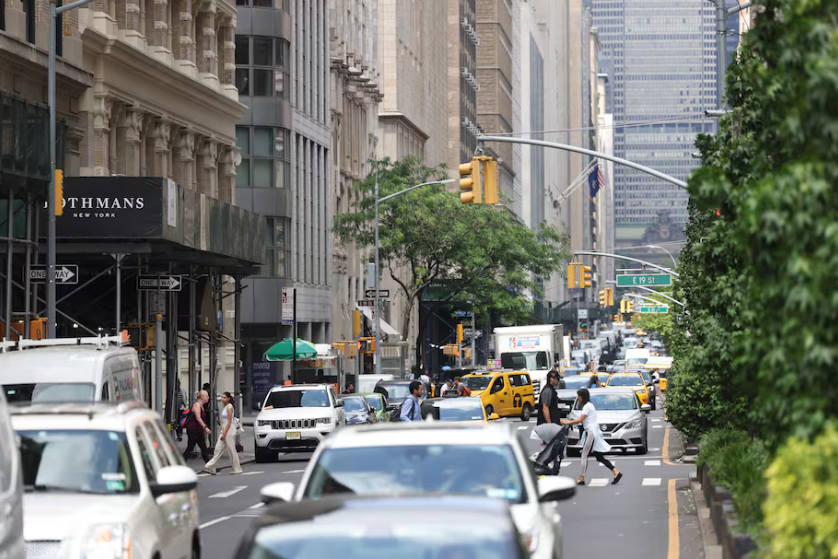
This article is more than
2 year old
What would have been America’s first congestion pricing experiment has been delayed by Gov. Kathy Hochul, leaving the city’s public transit system in a financial hole.
New York City was about to launch America’s first experiment in congestion pricing — a toll for drivers entering crowded parts of Manhattan that would have cut traffic and funded much-needed improvements to the city’s public transit system.
But New York Gov. Kathy Hochul (D) abruptly derailed the plan Wednesday. “After careful consideration I have come to the difficult decision that implementing the planned congestion pricing system risks too many unintended consequences,” she told reporters.
The goal had been to reduce traffic in the most heavily congested city in the United States, where average travel speeds have slowed to 7 mph. Nearly every driver entering Lower Manhattan would have paid a $15 toll, which was expected to raise $1 billion a year for public transportation while also reducing air pollution.
In theory, when the cost of congestion and pollution is transferred to the drivers who create it, they will cut back and use trains and buses instead of their cars. But many drivers, and politicians from neighboring states and the New York suburbs, complained that it would impose too heavy a financial burden on ordinary residents. Hochul’s shift shows how difficult it will be in the United States to implement congestion pricing — a climate-friendly policy that has worked around the world in cities including London, Singapore and Stockholm.
“If New York City can’t even do this, which is a place that has viable transit alternatives to driving, then this is going to be even more difficult in other regions that don’t have good alternatives,” said Zakhary Mallett, a research fellow in city and regional planning at Cornell University.
Studies have shown congestion pricing can reduce air pollution and sometimes bring significant health benefits, such as reduced rates of childhood asthma, to urban areas that see less traffic.
The policy also would have helped New York City meet its goal of cutting greenhouse gas pollution 80 percent by 2050. Transportation is the second-biggest source of the city’s CO2 emissions behind buildings, accounting for nearly a third, according to city data.
The lost toll revenue upends plans for long-delayed upgrades to public transit in New York.
“Public transit riders, millions of us every single day, were depending on congestion pricing to deliver the reliable and accessible subway we deserve, speed up our slowest-in-the-nation buses and clear up our air,” said Danny Pearlstein, policy and communications director at the Riders Alliance, an organization of transit riders. “Now we can’t depend on any of that. It’s a massive betrayal.”
Climate activist Bill McKibben criticized Hochul’s decision for its environmental impact. “This is one of the most aggressive anti-environmental (and anti quality of urban life) actions ever undertaken by a Democratic governor,” he tweeted.
Pushback from drivers and neighboring states
New York’s congestion pricing plan faced lobbying opposition and eight lawsuits from groups representing drivers and the governor of neighboring New Jersey. Hochul — who said two weeks ago at the Global Economic Summit in Ireland that the approach was a way of “making cities more livable” — said she changed her position because she worried the tolls would hurt New York’s economic recovery from the coronavirus pandemic.
Democratic Rep. Pat Ryan (N.Y.), who is running for reelection in a suburban district outside the city, cheered Hochul’s announcement. “Since Day 1, I’ve fought alongside countless Hudson Valley families against this unfair, uninformed and unacceptable congestion pricing plan,” he said in a statement. “Today, I’m proud to say we’ve stopped congestion pricing in its tracks.”
But Pearlstein said the shift represents a victory for wealthier suburban drivers over public transit commuters. “Call it the revenge of the 8 percent,” he said, “because 92 percent of people are coming in already by public transit from every assembly district around the city.”
Pulling the rug from under transit funding
Nixing congestion pricing leaves the Metropolitan Transit Authority (MTA), which is responsible for buses, commuter rail lines and the subway system, in a financial hole. The expected toll revenue would have allowed the MTA to raise a $15 billion bond to fund a subway expansion, new electric buses and rail cars, and other basic upgrades to decades-old transit infrastructure.
“Having the rug pulled out from under them is a big problem,” said Nicholas Klein, an assistant professor of city and regional planning at Cornell. “It’s unclear where the money is going to come from to replace this, or if it will at all.”
Losing an example
Hochul’s decision also derails what would have been the only example of congestion pricing in the United States.
“I think it makes it harder when Chicago or San Francisco or L.A. can’t point to New York City and say ‘They implemented congestion pricing and it worked out,’” Klein said. “It’s harder to say ‘Look at Stockholm or Singapore or London,’ because invariably people will say ‘Well, it worked in London, but will it work in the U.S.?’”
New York was supposed to be the easiest place to try congestion pricing because so many of its residents already use public transit.
“Every other city was going to face a much steeper climb,” Pearlstein said. “It didn’t seem like congestion pricing was going to spread like wildfire, but now the situation looks immeasurably worse.”
The fight continues
Activists have been pushing for some version of congestion pricing in New York City for decades, and the most recent plan, approved in 2019, was roughly a decade in the making.
While Hochul said she directed the MTA to “indefinitely pause the program,” transit activists and researchers say they’ll keep fighting to revive it.
“The pushes are going to keep going,” Mallett said. “Whether it will happen under Kathy [Hochul]’s watch, I am uncertain, but the effort is not dead, I can promise you that.”